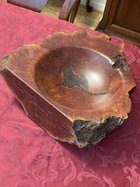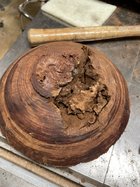I was turning the core I took from the rock hard burl, managed to break a concrete rated screw off in it while taking the faceplate off.
Plug cutters are your best friend when this happens. I mounted the cutter in my drill press and centered it on the screw stub and drilled down the length of the remaining screw. After that it was just a matter of tapping a screwdriver in beside the plug and breaking it off with the offending fragment in it.
Plug cutters are your best friend when this happens. I mounted the cutter in my drill press and centered it on the screw stub and drilled down the length of the remaining screw. After that it was just a matter of tapping a screwdriver in beside the plug and breaking it off with the offending fragment in it.


